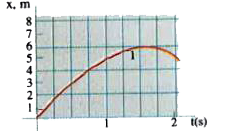Time intervals measured by clock give following readings: 1.25s, 1.24s, 1.27s, 1.21s and 1.28s. What is percentage relative error of observations?
0.02
0.04
0.16
0.016
The correct Answer is:D
To find the percentage relative error of the observations given, we will follow these steps:
Step 1: Calculate the Mean Time (t_mean)
We have the readings:
- t1 = 1.25 s
- t2 = 1.24 s
- t3 = 1.27 s
- t4 = 1.21 s
- t5 = 1.28 s
The mean time (t_mean) is calculated using the formula:
tmean=t1+t2+t3+t4+t55
Substituting the values:
tmean=1.25+1.24+1.27+1.21+1.285=6.255=1.25 s
Step 2: Calculate the Absolute Deviations (Δt_i)
Next, we calculate the absolute deviations (Δt_i) from the mean for each reading:
- Δt1 = |t_mean - t1| = |1.25 - 1.25| = 0.00 s
- Δt2 = |t_mean - t2| = |1.25 - 1.24| = 0.01 s
- Δt3 = |t_mean - t3| = |1.25 - 1.27| = 0.02 s
- Δt4 = |t_mean - t4| = |1.25 - 1.21| = 0.04 s
- Δt5 = |t_mean - t5| = |1.25 - 1.28| = 0.03 s
Step 3: Calculate the Mean Absolute Deviation (Δt_mean)
Now, we calculate the mean of these absolute deviations:
Δtmean=Δt1+Δt2+Δt3+Δt4+Δt55
Substituting the values:
Δtmean=0.00+0.01+0.02+0.04+0.035=0.105=0.02 s
Step 4: Calculate the Percentage Relative Error
Finally, we can calculate the percentage relative error using the formula:
Percentage Relative Error=(Δtmeantmean)×100%
Substituting the values:
Percentage Relative Error=(0.021.25)×100%=1.6%
Final Answer
The percentage relative error of the observations is 1.6%.
---
We have the readings:
- t1 = 1.25 s
- t2 = 1.24 s
- t3 = 1.27 s
- t4 = 1.21 s
- t5 = 1.28 s
tmean=t1+t2+t3+t4+t55
tmean=1.25+1.24+1.27+1.21+1.285=6.255=1.25 s
Next, we calculate the absolute deviations (Δt_i) from the mean for each reading:
- Δt1 = |t_mean - t1| = |1.25 - 1.25| = 0.00 s
- Δt2 = |t_mean - t2| = |1.25 - 1.24| = 0.01 s
- Δt3 = |t_mean - t3| = |1.25 - 1.27| = 0.02 s
- Δt4 = |t_mean - t4| = |1.25 - 1.21| = 0.04 s
- Δt5 = |t_mean - t5| = |1.25 - 1.28| = 0.03 s
Now, we calculate the mean of these absolute deviations:
Δtmean=Δt1+Δt2+Δt3+Δt4+Δt55
Δtmean=0.00+0.01+0.02+0.04+0.035=0.105=0.02 s
Finally, we can calculate the percentage relative error using the formula:
Percentage Relative Error=(Δtmeantmean)×100%
Percentage Relative Error=(0.021.25)×100%=1.6%
The percentage relative error of the observations is 1.6%.
Similar Questions
SN1 is observed in
View SolutionThe length of a pendulum is measuredas 1,01 m and time for 30 oscillation is measured as one minute 3 s. Error length is 0.01 m and error in the 3 s. The percentage error in the measurement of acceleration due to gravity id,
View SolutionFind the average velocity for the time intervals Δt=t2−0.75 when t2 is 1.75 ,1.25 and 1.0 s. What is the instantaneous velocity at t=0.75 s?
 View Solution
View SolutionTime for 20 oscillations of a pendulum is measured as t1=39.6s,t2=39.9 and t3=39.5s. What is the precision in the measurements ? What is the accuracy of the measurement ?
View SolutionRani’s weight is 25% that of Meena’s and 40% that of Tara’s. What percentage of Tara’s weight is Meena’s weight ?
View SolutionTime for 20 oscillations of a pendulum is measured as t1=39.6s,t2=39.9s,t3=39.5. What is the precision in the measurements ? What is the accuracy of the measurement ?
View SolutionThe length of a pendulum is measured as 20.0 cm. The time interval for 100 oscillations is measured as 90 s with a stop watch of 1 s resolution. Find the approximate percentage change in g.
View SolutionA physical quantity A is dependent on other four physical quantities p,q,r and s as given by A=√pqr2s3. The percentage error of measurement in p,q,r and s are 1%,3%,0.5% and 0.33% respectively, then the maximum percentage error in A is
View SolutionThe least count of a stop watch is 0.2 s, The time of 20 oscillations of a pendulum is measured to be 25s. The percentage error in the time period is
View SolutionThe least count of a stop watch is 0.2 s, The time of 20 oscillations of a pendulum is measured to be 25s. The percentage error in the time period is
View Solution

